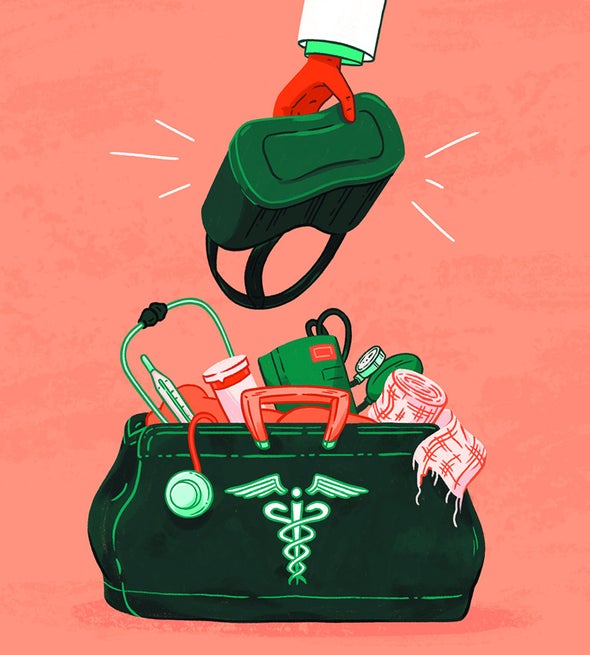If you still think of virtual reality as the province of dystopian science fiction and geeky gamers, you had better think again. Faster than you can say “Ready Player One,” VR is starting to transform our world, and medicine may well be the first sector where the impact is profound. Behavioral neuroscientist Walter Greenleaf of Stanford University has been watching this field develop since the days when VR headsets cost $75,000 and were so heavy, he remembers counterbalancing them with a brick. Today some weigh about a pound and cost less than $200. Gaming and entertainment are driving current sales, but Greenleaf predicts that “the deepest and most significant market will be in clinical care and in improving health and wellness.”
Even in the early days, when the user entered a laughably low-resolution world, VR showed great promise. By the mid-1990s research had shown it could distract patients from painful medical procedures and ease anxiety disorders. One initial success was SnowWorld, which immersed burn patients in a cool, frozen landscape where they could lob snowballs at cartoon penguins and snowmen, temporarily blocking out the real world where nurses were scrubbing wounds, stretching scar tissue and gingerly changing dressings. A 2011 study with 54 children in burn units found an up to 44 percent reduction in pain during VR sessions—with the bonus that these injured kids said they had “fun.”
Another success came in the wake of 9/11. Psychologist JoAnn Difede of NewYork-Presbyterian/Weill Cornell Medical Center began using VR with World Trade Center survivors suffering from post-traumatic stress disorder (PTSD) and later with soldiers returning from Afghanistan and Iraq.
In Difede's laboratory, I saw the original 9/11 VR program with its scenes of lower Manhattan and the newer Bravemind system, which depicts Iraqi and Afghan locales. Developed with Department of Defense funding by Albert “Skip” Rizzo and Arno Hartholt, both at the University of Southern California, Bravemind is used to treat PTSD at about 100 U.S. sites. The approach is based on exposure therapy, in which patients mentally revisit the source of their trauma guided by a therapist who helps them form a more coherent, less intrusive memory. In VR, patients do not merely reimagine the scene, they are immersed in it.
Difede showed me how therapists can customize scenes in Bravemind to match a patient's experience. A keystroke can change the weather, add the sound of gunfire or the call to prayers. It can detonate a car bomb or ominously empty a marketplace. An optional menu of odors enables the patient to sniff gunpowder or spices through a metal tube. “What you do with exposure therapy is systematically go over the trauma,” Difede explains. “We're teaching the brain to process and organize the memory so that it can be filed away and no longer intrudes constantly in the patient's life.” The results, after nine to 12 gradually intensifying sessions, can be dramatic. One 2010 study with 20 patients found that 16 no longer met the criteria for PTSD after VR treatment.
Until recently, large-scale studies of VR have been missing in action. This is changing fast with the advent of cheaper, portable systems. Difede, Rizzo and three others just completed a randomized controlled trial with nearly 200 PTSD patients. Expected to be published this year, it may shed light on which patients do best with this high-tech therapy and which do not. In a study with her colleague, burn surgeon Abraham Houng, Difede is aiming to quantify the pain-distraction effects of a successor to SnowWorld called Bear Blast, a charming VR game in which patients toss balls at giggly cartoon bears. They will measure whether burn patients need lower doses of intravenous painkillers while playing.
Greenleaf counts at least 20 clinical arenas, ranging from surgical training to stroke rehabilitation to substance abuse where VR is being applied. It can, for example, help recovering addicts avoid relapses by practicing “refusal skills”—turning down drinks at a virtual bar or heroin at a virtual party. Brain imaging suggests that such scenes can evoke very real cravings, just as Bravemind can evoke the heart-racing panic of a PTSD episode. Researchers foresee a day when VR will help make mental health care cheaper and more accessible, including in rural areas.
In a compelling 2017 paper that reviews 25 years of work, Rizzo and co-author Sebastian Koenig ask whether clinical VR is finally “ready for primetime.” If today's larger studies bear out previous findings, the answer seems to be an obvious “yes.”


